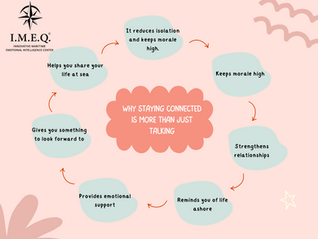Seafaring and Mental Health Issues
- Penelope Robotis Psychologist Psychotherapist
- Jul 24, 2017
- 3 min read

Seafaring is a high risk occupation with specific characteristics and is performed in rather special contexts in regards to the physical and psychosocial point of view. When we talk about seafaring, we can imagine the difficulties individuals must face on a long journey with loneliness. However, loneliness is one of many principals psychologists are concerned with. Many sociological studies have focused on work-related stress upon the vessel and its implications in the long-run. Work-related stress affects the seafarers to a high degree and it is quite different from stress in other working environments. The characteristics of this work-stress related include possible dangers such as accidents, injuries and diseases.
The demands of work at sea , especially the effects of fatigue, psychosocial risks , poor management can increase mental stress and exacerbate pre-existing conditions. Multiple studies report increased prevalence rates of stress, substance abuse, depression generalized anxiety among seafarers( Iversen R., (2012), and poor health and high job stress while have been associated with increased levels of depression and anxiety ( Kim J.H., & Jang S.N., 2016). Alcohol consumption on board among seafarers ranges from 10 percent to 30 percent, while the prevalence of cannabis use in a month ranged from 3 to 16 percent concluding that the prevalence of smoking and alcohol consumption was higher than for the general population (Pougnet R., et.al 2014) .
It has been well established that a number of the risks and hazards are associated with seafaring i.e. fatigue, long working hours, noise, extreme weather conditions, loneliness, isolation, exposure to noise and difficult working conditions along with risk of accidents and piracy increase the risk for stress and set the stage for the onset of mental health problems ( Oldenburg M., & et. al, 2010). Studies on mental health of seafarers has consistently reported that mental health of seafarers is poor and often fatal; suicidal rates reported to be as high as 5.1 percent ( Iversen, R.T.B., 2012) Depression, anxiety, suicide, alcohol and substance abuse remain major issues of concern among seafarers, and a significant issue for the maritime industry to be addressed. Multiple sources report that the majority of accidents and incidents on board are attributed to human error, and a number of scholars point to the need for implementation of multidimensional recruitment methods and policies to ensure proper selection of seafarers with personality traits, profile attributes and characteristics significant to ensure optimum job performance, safety, adjustment and adaptation onboard (Popa C.,et al., 2015). While amendments and regulations on safety issues have increased over the years, it appears that one of the most critical issue onboard remains largely unaddressed : Mental Health of Seafarers.
Mental health is the result of the interaction between biological, psychological and social factors and increasing evidence point to work related factors that play a key role in the development of mental health issues in the workplace. According to the World Health Organization , key factors include workload, lack of control , monotonous work tasks, role ambiguity , conflict, poor interpersonal relationships, poor working conditions, inequity .
Mental health problems manifest symptoms that cause significant suffering for individuals and negatively affecting their work performance. Stress , anxiety and depression has been estimated to affect 40 million workers across 15 countries of the European Union. The total cost to employers resulting from loss of productivity including absenteeism and presentism was estimated to be 271 billion ( European Agency for Safety and Health at Work across 15 European countries . It has been reported that 450 million people worldwide are suffering from some form of mental disorder; 121 million suffer from depression, 70 million from alcohol-related problems, while 10-20 million have attempted suicide ( WHO 2002).
In 2000 mental and neurological disorders accounted for 12.3 percent of disability adjusted life years ( the total number of years of healthy life lost from death or disability). It has been estimated that 5.8 percent of men and 9.5 percent of women will manifest a depressive episode in any year; and if this trend perpetuates, depression will be the second cause of disability by the year 2020.
In conclusion, seafaring is considered one of the most high risk occupations with strict medical and physical examinations being mandatory; but which may fail to reveal mental disturbances or identify risk factors that could impede job performance or compromise personal, crew or vessel safety.





































































































Comments